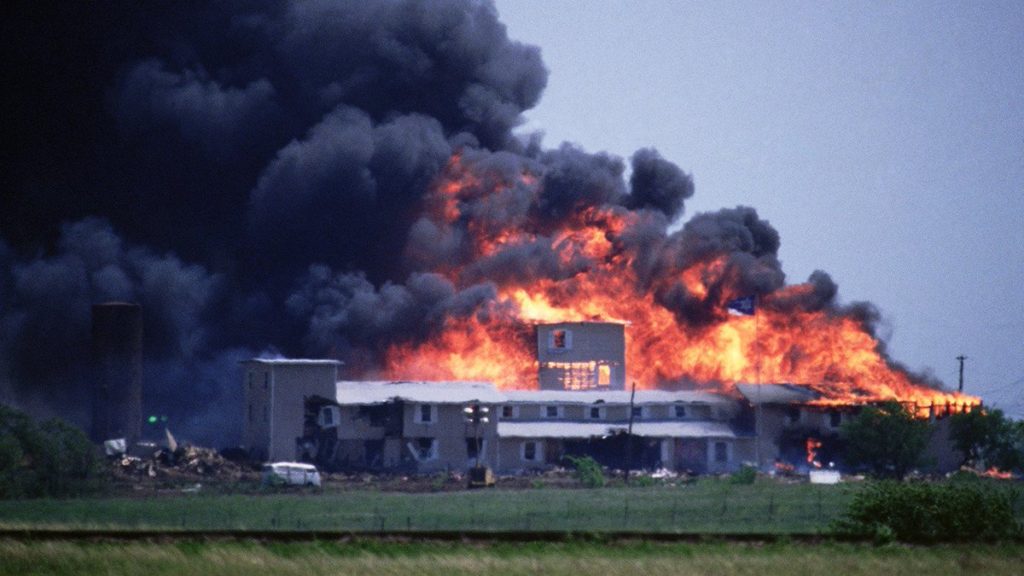
Over the summer I finally caught up with John and Drew Dowdle’s Waco (2018) and two things were immediately clear to me before the first episode was over. Firstly, the Dowdle brothers are extremely sympathetic towards the Waco Branch Davidians and approach these characters from a highly sentimentalized liberal viewpoint. Secondly, that this miniseries was as reliant upon William Gazecki’s film Waco: The Rules of Engagement (1997) as it was upon the eyewitness accounts of David Thibodeau and Gary Noesner. And I can’t say that Waco has more to offer as entertainment or information than Gazecki’s film. In fact, the Dowdle Brothers appear to have copied the format of Gazecki’s film in so far as both accounts of these events are slanted in much the same way. And each film, in its own way, relegates the spiritual aspects of the narrative to the background.
History remembers David Koresh as the self-proclaimed second coming of Christ, who dealt in arms and had a number of wives. He earned for himself the moniker “the sinful messiah” in the press, as well as a reputation equal to that of Jim Jones. Gazecki’s film does well to discredit such biases with factual information regarding the political practices of Waco Branch Davidians, and the history of the organization that led to the conflict with the ATF and FBI. But it is not the history that concerns me at this moment, my interest is in the presentation of the history.
As human beings we often align ourselves to those who are sympathetic to our own moral beliefs. This is the one major problem with Waco: The Rules Of Engagement. As I said above, the film presents a number of useful facts that better help the audience understand Koresh and the Davidians as an organized community. These facts are more inclusive and precise of the history surrounding the organization than most documentaries on the subject. However, there is an evident bias as to the kind of information given.
Gazecki deems it necessary to exchange the sympathies inherent to religious understanding in favor of more superficial and visually motivated sympathies. Perhaps this is because of the medium in which he is working, or perhaps because he does not wish his audience to have any spiritual affiliation with the beliefs of the Waco Branch Davidians. What sympathy that is afforded David Koresh and his followers is as extensive as Koresh’s edited down video messages allow.
While trapped in the compound Koresh videotaped the daily life of the Davidians as well as a series of messages addressed to the ATF agents outside. This is the material Gazecki is drawing from. In this footage, at least in the footage Gazecki has cut into his film, Koresh is seen three times with one of his children in his lap speaking calmly about the Seven Seals that define his faith. This image of Koresh as father rather than criminal, rapist and brain-washer is the single moment in the film in which the audience can relate to the subject directly.
Gazecki is careful to maintain a seemingly objective distance from his subject throughout. The image of Koresh described above do not appear in the film until very close to the moment the ATF ignites the compound. Gazecki’s strategy is for dramatic effect. But it is the tactics of Waco: The Rules Of Engagement that negate the audiences’ understanding of the Davidian beliefs, therefore neglecting their perspective entirely.
The history in Waco: The Rules Of Engagement is thus the history recorded by paranoid liberals; the obvious audience for the film in the first place. It is not the filmmaker’s priority to inform the audience of the Davidian perspective, or enhance any understanding along such a vein. Rather, priority is given to the audience simply understanding that the Waco Branch Davidians are sick people, yet people none-the-less. That the single tragedy is that they burned alive in their compound; to say nothing of the corruption of innocent lives by Koresh, the ignorance of the American government, the paranoia of the media, etc. Gazecki seems unwilling to entrust his audience with the weightier problem of having to assess the events and circumstances of Waco for themselves. This is where Waco: The Rules Of Engagement fails.
